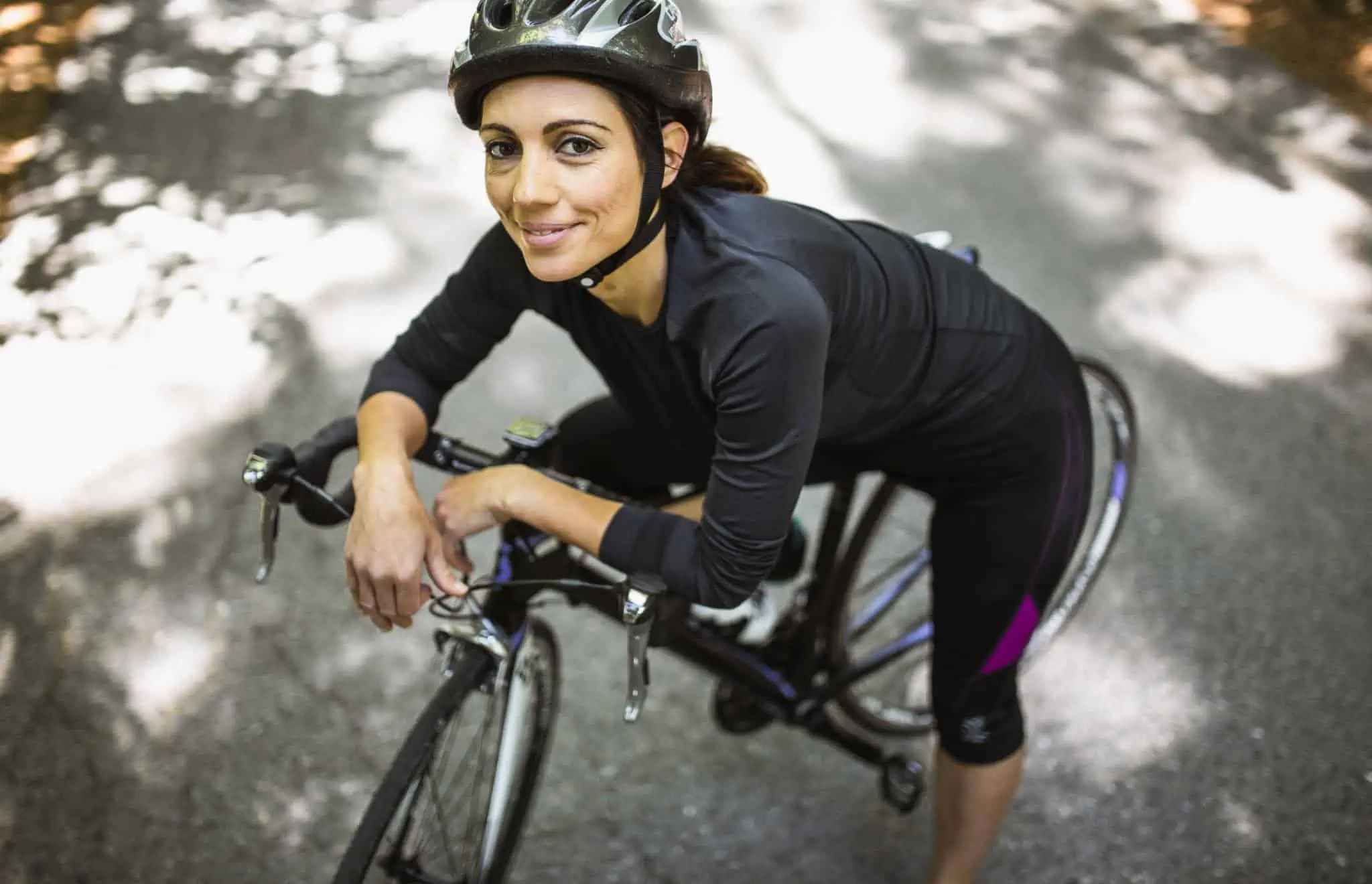Cycling delivers incredible health and fitness benefits like improved cardiovascular endurance, muscle strength, weight loss, and better mental health. It’s also an extremely popular recreational activity and competitive sport.
But simply hopping on a bike and pedaling aimlessly won’t get you very far. It would be best to have a structured training plan tailored to you to achieve your cycling goals, whether completing your first-century ride, shedding pounds, gearing up for a race, or improving your abilities.
This comprehensive guide provides everything you need to create your optimal cycling training plan based on your objectives, abilities, and time constraints. You’ll learn:
- How to assess your current fitness and cycling skills to establish smart goals
- Training zones, sessions, and periodization models that methodically build fitness
- Creating a customized weekly and monthly training schedule
- Tracking performance metrics to make data-driven training adjustments
- Proper bike fit, equipment, nutrition, and hydration strategies
- Fitting training into a busy life and preventing overtraining
With cycling disciplines like road, mountain, track, and cyclo-cross, there’s something for everyone. This guide works for beginners establishing an aerobic base and skill foundation up to seasoned racers sharpening speed and strategy.
Whether your goal is completing your first metric century or finally podiuming at a criterium, a thoughtfully designed training plan is the vehicle to get you there. It provides structure and purpose to methodically develop your abilities without risking burnout, fatigue, and injury from haphazard training.
Becoming a stronger, fitter cyclist requires commitment but is deeply rewarding. We’ll equip you with the knowledge to create your perfect training plan tailored to your unique needs and objectives. Let’s get pedaling toward your cycling goals!

Establish Your Goals and Assess Your Current Abilities
Creating a cycling training plan starts with clearly understanding what you want to accomplish and an honest assessment of your current fitness and abilities. Your goals will determine the type of training plan you need, and your current level will dictate where you’re starting from.
For goal-setting, be specific about what you want to achieve. Examples include:
- Completing your first-century ride.
- Finishing a Gran Fondo event.
- Dropping 5 minutes off your 40K trial.
- Boosting your overall cycling fitness.
Outline measurable, time-based objectives to shoot for.
Next, audit your present cycling skills and fitness. Consider factors like:
- Your comfortable riding distance and duration
- Average speed and power output
- Technique and bike handling capabilities
- Core strength and muscle endurance
- Current training schedule and recovery needs
New riders should focus on establishing an aerobic base, bike handling skills, and getting comfortable on the bike. Intermediate cyclists can work on building fitness and preparing for first events. Competitive riders can hone race strategies.
It would be best if you also accounted for cycling discipline. Training plans will differ for road, mountain, track, cyclo-cross, etc. Even within road cycling, you may focus on different areas like sprints, endurance, hills, or intervals based on your strengths.
Being realistic about your starting point allows you to progress at an appropriate rate and prevent overtraining, fatigue, and burnout. Overly aggressive training plans can lead to injury and be demotivating if you can’t keep up.
Check your schedule and lifestyle factors as well. How much time can you commit to training each week? What days work best? Do you need flexibility for family or work obligations? This will influence how you structure your plan.
You can chart the path from point A to point B with clear goals and self-awareness of your current abilities. This puts you in a position to start mapping out the training phases that will get you there.
The Essential Elements for Building Your Custom Training Plan
Once you’ve established your goals and current abilities, you can begin strategically incorporating the fundamental components that will spur you toward those goals. Explore the critical elements for designing your personalized, high-performance cycling training plan.

Choosing the Right Training Sessions
The training sessions are individual workouts that each serve a specific purpose within your overall regimen. Carefully programming them provides the progressive overload needed to drive physiological adaptation. Here are some of the most effective sessions to include:
Long Slow Distance (LSD): As the name implies, these longer rides of 2-5+ hours are done at an easy, aerobic pace where you can carry a conversation. Building this aerobic base establishes an endurance engine and prevents burnout from excessive intensity. Beginners should focus on gradually increasing weekly volume.
Intervals: Repeated shorter efforts from 30 seconds to 5 minutes at an intense effort, followed by recovery periods. Interval sessions build speed and boost lactate threshold. For example, a beginner plan may start with 4×2 minutes hard with 2 minutes recovery, then build up to 10×30 seconds all-out with 4 minutes rest.
Tempo: Sustained hard but controlled efforts just below lactate threshold, around 80-90% max heart rate. Tempo work strengthens your stamina and economy. A sample tempo workout is 40 minutes at the moderately hard perceived effort.
Hill Repeats: Short, intense uphill intervals targeting climbing power and leg strength. Sequence 8-10 hill repeats of 30 seconds duration with downhill recovery in between.
Skills Development: Focused practice of bike handling skills like cornering, shifting, climbing, and descending techniques. Do an isolated session or skills drills during warm-ups.
Recovery Rides: Short, easy spins facilitating active recovery between harder sessions. Keep these under an hour with minimal effort.
Deliberately scheduling different sessions throughout the training week provides balance and variety while cumulatively building abilities. Tailor sessions to your objectives, cycling discipline, and current level. Track data like distance, elapsed time, speed, heart rate, power, etc., to gauge progress over time.
Quantifying Intensity Using Training Zones
Training zones allow you to quantify your effort and intensity for different workouts to target specific physiological adaptations. While subjective perceived exertion works, most systems use heart rate, power output, and pace metrics.
For example, heart rate zone training uses % of max heart rate ranges:
- Z1: 60-75% max HR, easy aerobic
- Z2: 76-85% max HR, moderate aerobic
- Z3: 86-90% max HR, tempo effort
- Z4: 91-95% max HR, lactate threshold
- Z5: 96-100% max HR, max effort
Heart rate data can be gathered using heart rate monitors like chest straps or wrist-based wearables. This allows you to train within specific zone ranges during workouts and track your heart rate response over time.
Utilizing Strategic Periodization
Periodization involves dividing your training into set cycles and phases that allow for progressive, structured overload. The training stages can range from microcycles of 1 week up to macrocycles lasting a full year. Popular models include:
- Linear – gradually increasing intensity over each mesocycle
- Reverse Linear – starting high intensity, then progressively lowering
- Block–alternating mesocycles focused on different abilities
For example, an 18-week beginner plan may dedicate 6 weeks to aerobic base training followed by higher intensity build phases leading up to an event. Recovery weeks are built into each macrocycle to absorb the training. Experienced riders may employ more advanced techniques like dual peaked periodization. The training phases provide mental freshness along with physical development.
Recovery and Rest
Hard training sessions drive physiological improvements, but without adequate rest and recovery, your body fails to adapt, and you risk overtraining, fatigue and burnout. Ensure your plan schedules easier recovery days after intense efforts. Take at least one full rest day per week, up to 2-3 for newer riders. Periods of reduced volume, like recovery weeks, allow your body to regenerate and super compensate.
Use active recovery techniques like easy spinning, stretching, compression, massage, foam rolling, contrast baths, and sufficient sleep. Underutilized methods like HRV monitoring, sleep tracking, and fatigue analysis via wearables can also optimize recovery.
By thoughtfully and synergistically incorporating all of these training plan elements, you will be well-equipped to improve your cycling performance and reach your goals.
Constructing Your Structured Training Calendar
Once you’ve set goals, evaluated your abilities, and learned about the core components, it’s time to map out your training calendar. This outlines your workouts over a specific time period, balancing training and recovery. The thoughtful design of your schedule will propel your fitness forward.
First, determine your training cycle’s overall duration and focus based on your periodization model. Examples are:
- 12-week base fitness phase
- 8-week Century training plan
- 16-week build to peak race season
Next, plug in key events, challenges, or target races you are training for and work backward to schedule training phases leading up to them. Allow proper time for foundational training.
Within each training phase, begin scheduling your weekly microcycles. It is useful to have a standard template for consistency, for example:
- Monday: Rest
- Tuesday: Intervals
- Wednesday: Tempo/Threshold Work
- Thursday: Recovery Ride
- Friday: Skills Session
- Saturday: Long Ride
- Sunday: Complementary Cross-Training
Customize as needed for your unique objectives, allowing for adequate recovery between harder sessions. Consistency breeds adaptation.
Deliberately modulate the training stimuli week-to-week through volume, duration, intensity, climbing, etc., to spur continued gains, known as progressive overload. For example, increasing weekly mileage, interval intensity, or total climbing. Don’t increase too aggressively to prevent overtraining.
Strategically incorporate easier recovery weeks every 3-6 weeks where you back off volume and intensity by ~30%. This allows your body to absorb the training and super compensate.
Listen to feedback from your body and be willing to take extra rest days when needed if you feel tired or drained. Training plans must remain flexible.

Additional Tips for Maximizing Your Training Schedule:
- Ensure adequate rest before events or challenges – taper training 7-14 days prior through reduced volume while maintaining intensity.
- Schedule key workout sessions during times you know you’ll be consistent and motivated.
- Build in scheduling contingencies for when life events come up.
- Use indoor training for poor weather and busy days.
- Schedule ancillary activities like stretching, foam rolling, and strength training.
- Utilize training software or apps to automate scheduled workouts and tracking.
- Plan regular benchmark tests every 4-6 weeks to gauge fitness improvements through power, speed, and heart rate metrics.
Thoughtfully structuring your training calendar provides a blueprint to success. But remains flexible to listen to your body’s responses. Stick to the schedule as much as reasonably possible for optimal results. Consistency and progressive overload over time lead to increased performance.
Building Your Custom Training Schedule for Cycling Success
Crafting a structured training calendar is crucial for continuous fitness gains. Thoughtfully scheduling your workouts provides actionable planning while allowing flexibility. Follow these steps to design your training calendar tailored to your cycling goals.
Choose Your Macrocycle Duration
First, frame your overall training period and focus. Examples are:
- 12-week base fitness phase
- 16-week Century training plan
- 6-month build to peak race season
Base it on your primary event/goal, allowing adequate time to establish fitness. Typically 8-16 weeks for a single macrocycle training block is recommended for most riders.
Schedule Your Sessions
Plug in your standard weekly microcycles using a template like:
- Monday: Rest day
- Tuesday: High-intensity intervals
- Wednesday: Tempo + Core workout
- Thursday: Active recovery ride
- Friday: Skills/Drills session
- Saturday: Long endurance ride
- Sunday: Low intensity with form focus
Customize sessions and schedules based on your limitations, recovery needs, and goals. Consistency of 2-6 key sessions weekly breeds adaptation. Beginners should schedule skills development. Racers may incorporate more intense sessions.
Incorporate Periodization
Deliberately modulate training stimuli week-to-week through progressive overload – increases in volume, intensity, duration, climbing, etc. For example, increasing interval intensity by 5% weekly or adding 5 miles to long rides. Don’t increase too rapidly.
Schedule a recovery week every 3-6 weeks where you reduce training stress by ~30%. This absorption allows your body to compensate super and improve fitness.
Taper training 7-14 days pre-events by cutting volume in half while maintaining intensity. This sheds fatigue and maximizes freshness.
Listen To Your Body
Remain flexible and take extra rest when needed. Increase recovery days if feeling drained or fatigued. Training plans are a guide, not a gospel.
Use RPE (perceived exertion rate) and wearables to monitor workout strain, HRV, sleep, and recovery to inform adjustments.
Other Schedule Maximization Tips:
- Ensure key sessions occur when you’re motivated and energetic
- Build contingencies for disruptions – travel, weather, life events
- Leverage indoor training for bad weather and busy days
- Integrate cross-training, stretching, foam rolling, and strength training
- Use training software to automate scheduled workouts
- Plan testing every 4-6 weeks to track progress in speed, power, endurance
Consistency and dedication to your thoughtfully structured training calendar will pay dividends on your fitness. But remain agile to respond to your body’s signals. Keep grinding towards your cycling goals.
You May Loved:
24 INCH BIKE FOR WHAT SIZE PERSON?
How Many Times a Week Should You Train for Cycling?
Monitoring Performance Metrics to Track Improvements
To gauge the effectiveness of your training, consistently tracking key performance metrics provides objective data on your progress over time. What you measure, you can improve.
Key Training Metrics to Track
Heart Rate (HR) – Measured via chest strap or wrist optical sensors. Look at average and max HR for sessions along with recovery HR. Improved cardiovascular fitness is reflected by lower HR at a given power output.
Power – Measured via dedicated power meters on bikes or smart trainers. Increased power demonstrates improved fitness and strength. Look at sustained power over intervals or climbs along with max power.
Speed – Measured via bike computer. Faster speeds at the same perceived effort reflect gains in endurance and economy. Top-end speed is also important for sprinters.
Cadence: Your pedaling RPM is measured through sensors or computers. The optimal cadence varies but is often 80-95 RPM. A higher cadence may indicate an improved economy.
Distance and Elevation: Longer distances and more climbing demonstrate increased endurance and capability over time.
Rate of Perceived Exertion: Your subjective 1-10 rating of how hard training feels provides useful perceived intensity data, especially when power/HR is unavailable.
Training Tools to Track Data
Dedicated cycling computers like Garmin or Wahoo devices record and compile key metrics from sensors. Heart rate monitors, power meters, and speed/cadence sensors seamlessly feed computer data.
Smart trainers also quantify and control resistance based on target power, gradient, etc. Paired with training apps, they provide deep performance analytics.
Fitness wearables like watches and activity trackers can also record HR, sleep, steps, and other recovery metrics.
Training journals, logs, and apps to manually record your feelings allow you to look for trends.
Tips for Maximizing Metrics
- Establish baseline benchmark numbers for metrics like 5 min and 20 min power, max HR to compare against.
- Record all key data immediately after every workout while fresh.
- Analyze trends looking for positive, progressive overload as you get fitter.
- Take periodic benchmark tests every 4-6 weeks to quantify gains.
- Adjust your training plan based on plateaus or regressions in metrics.
- Deliberately train to improve your weaknesses reflected in metrics.
- Utilize metrics for motivation by demonstrating tangible improvements over the training cycle.
Carefully tracking performance metrics provides invaluable data-driven insight into your training effectiveness and dialing in your cycling fitness peaks. Quantify your progression toward your cycling goals.
Dialing In Your Cycling Gear and Bike Fit
Properly fitted equipment and a bike tailored to your body are critical for comfort, efficiency, and injury prevention when training. Optimizing these factors makes the hours you invest vastly more productive.
Choose the Right Bike for Your Discipline
Having a bike designed for your cycling discipline provides the best riding experience and capability. Key options:
- Road Bikes – Lightweight and aerodynamic for speed. Drop handlebars.
- Mountain Bikes – Rugged, stable suspension system for trails. Flat handlebars.
- Cyclo-cross – Lightweight like road bikes but with wider tires for traction.
- Triathlon/Time Trial – Very aerodynamic frame and integrated storage.
Within each discipline, bikes have sizes, geometries, and components optimized for different specialties like sprinting vs. climbing. Test ride models to select the best bike tailored to your goals.
Dial In Your Individual Bike Fit
Even more important than the type of bike is the fit. A bike fitted to your unique body dimensions optimizes comfort, power transfer, and injury avoidance.
Key bike fit dimensions are:
- Saddle Height – Set so legs slightly bend at the bottom of the pedal stroke.
- Saddle Fore/Aft – Determines knee placement over the pedal spindle.
- Handlebar Height – Largely based on flexibility and riding style.
- Handlebar Reach – The distance to the bars is based on arm/torso length.
- Cleat Position – Foot alignment affecting knee tracking.
Getting professionally fit using measurement tools, motion capture, and muscle testing is ideal, but DIY methods also work. Set the level of the saddle and use proper posture. Regularly reassess fit.
Complementary Cycling Gear
Further optimize your riding with proper kit like:
- Cycling Shoes – Stiff soles transfer more power. Choose the right cleat type.
- Padded Shorts – Reduce friction and absorb vibration for long rides.
- Helmet – Safely protect your head in the event of a crash. Ensure proper, snug fit.
- Eyewear – Block wind, debris, and glare while cycling.
- Gloves – Added comfort and shock absorption.
- Hydration Packs – Carry water hands-free during long training rides.
Invest in quality cycling clothing and accessories fitting your needs to get the most from your training. Test gear thoroughly for personal preference.
With dialed equipment and bike fit, every mile will boost your cycling fitness rather than wear you down. You’ll ride faster, stronger and reduce injury risk.
Fueling Your Training with Strategic Nutrition and Hydration
The right nutrition and hydration before, during, and after training sessions optimizes performance, recovery, and progress. Strategically fueling your body provides energy for mileage while aiding adaptation.
Pre-Ride Nutrition
Consume a light carb-based meal 2-4 hours pre-ride to top off muscle glycogen. Good options are oatmeal, banana, granola, toast, or yogurt. Stay hydrated while sipping water.
Limit fat, protein, and fiber, which delay gastric emptying. Coffee before morning rides can boost endurance.
Bring easily digestible on-bike carbs like gels, chews, bars, or figs. Carb load with ~1 gram of carbs per kg of body weight per hour for rides over 60-90 mins.
Hydration While Cycling
Dehydration hampers endurance and thermoregulation. Sip electrolyte drinks like sports mixes consistently throughout rides longer than 60 minutes.
Consume 16-24 oz. of fluid per hour based on ride intensity, temperature, and individual sweat rate. If thirsty, you are already dehydrated.
Plain water is fine for shorter efforts under 60-90 minutes. Weigh yourself pre/post-long rides to gauge hydration needs and losses.
Monitor urine color – dark yellow indicates dehydration. Supplement electrolytes on hot rides or if cramping.
Post-Ride Recovery Nutrition
Eat a carb/protein meal within 30-60 minutes post-ride to replenish glycogen, repair muscle, and maximize gains. Chocolate milk, smoothies, or recovery shakes all work well.
Consume ~0.5 grams of carbs per kg bodyweight along with 15-25 grams of protein to optimize the 2-hour anabolic window after training.
Hydrate with plenty of water and electrolytes to rehydrate. Weigh yourself again to check fluid loss. Use compression garments, massage, and sleep to speed recovery.
Strategically fueling and hydrating for your cycling training optimizes energy, recovery and reduces GI issues. Test nutrition on longer rides before races or events.
12-Week Beginner Cycling Training Plan
Seeing a concrete sample training plan helps reinforce how to apply the methodology and structure your own regimen as a cycling novice. Here is an outline of a 12-week beginner cycling training plan:

Overview
This plan progresses from building an aerobic base to developing strength and speed. It mixes in skills sessions along with complementary cross-training and strength work. There is 1 rest day, 1 HIIT or hill repeats session, 1 tempo ride, 1 longer endurance ride, and 1-2 shorter recovery and skills rides each week.
Weekly Schedule Template
Monday: Rest Tuesday: HIIT Intervals or Hill Repeats – 30-45 min. Wednesday: Tempo Ride – 45-60 min Thursday: Active Recovery Ride – 30-45 min. Friday: Skills and Drills Session – 30-45 min. Saturday: Long Endurance Ride – 60-90 min. Sunday: Yoga/Core Strength – 45-60 min
Periodization Schedule
Weeks 1-4: Aerobic Base Phase – Zone 2 rides building mileage + skills development Weeks 5-8: Build Phase – Add tempo, sweet spot efforts, some Zone 4 intervals Weeks 9-10: Strength Phase – Hill repeats, HIIT, increase difficulty Weeks 11-12: Taper – Ease off volume, maintain intensity
Weekly Progression
- Long ride: Start at 60 min, increase 5-10 min each week up to 90 minutes
- Interval day: 4×2 min hard efforts up to 6×3 minutes by week 12
- Recovery ride: 30 min Zone 1 spin
This beginner plan provides a framework, periodization, and structure to apply training principles and continue progressing on the bike. Customize to your unique strengths, weaknesses, and schedule.
Avoid and Recover From Common Cycling Injuries
Cycling delivers huge fitness gains but also comes with injury risks. Repetitive pedaling motions combined with poor bike fit, muscle imbalances, and overtraining often lead to painful overuse injuries for riders. Crashes also frequently cause acute injuries. Staying off the bike long-term hampers your training and progress. Luckily there are effective prevention and recovery strategies to keep you cycling injury-free.
Knee injuries, lower back pain, numb hands, tendinitis, and soft tissue inflammation are some of the most common cycling overuse injuries. They arise from muscular imbalances and tissue strain that are never fully resolved. Road rash, fractures, sprains, and bruises are acute injuries from accidents.
Proper bike fitting tailored to your body is crucial for injury prevention. Building strength in core stabilizers, hips, and glutes also compensates for cycling’s repetitive nature. Maintaining flexibility through stretching and foam rolling helps too.
When injuries do occur, rest days reduce activity-related inflammation so your body can heal. Icing minimizes swelling and discomfort. Massage increases blood flow to aid recovery. With patience and proper care, most cycling injuries can fully heal.
The key is easing back into cycling gradually once pain-free and cleared by a medical professional if needed. Starting with short rides focused on good form and building slowly avoids re-aggravation. Maintain your strength training and flexibility work too.
This guide will equip you with cycling injury prevention and recovery strategies to stay riding consistently. Let’s explore proven techniques to keep you pedaling strongly toward your goals!
Common Cycling Injuries to Watch Out For
Certain injuries are prevalent among cyclists due to the repetitive pedaling motion and prolonged riding position. Being aware of these common cycling injuries and their causes is key to prevention and prompt treatment when they occur.
Knee injuries like patellofemoral pain syndrome, iliotibial band (ITB) syndrome, and general knee strain are frequently experienced by cyclists. The repetitive motion can irritate the tissue around the knee joint. Poor bike fit and muscular imbalances also contribute.
Lower back pain is another common complaint arising from the flexed back position during riding. Weak core strength fails to stabilize and support the spine properly. Fit issues also cause back strain.
Numbness or tingling in the hands results from compression of nerves and reduced blood flow. Prolonged weight supported on the hands constricts nerves. Susceptible riders may develop carpal tunnel or handlebar palsy.
The rotator cuff shoulder muscles are also vulnerable to overuse from weight bearing on the handlebars. Rotator cuff tendinitis causes dull shoulder aches.
Finally, cuts, scrapes, and bruises are routine acute injuries. Collisions and crashes cause more severe injuries like fractures, dislocations, and trauma. Wearing safety gear can reduce damage.
Recognizing common cycling injuries helps you take preventative measures. Addressing them early optimizes recovery time and avoids developing chronic issues. We’ll cover injury prevention and treatment techniques next.
Prevent Cycling Injuries Through Proactive Measures
Cycling delivers outstanding fitness benefits but also poses injury risks. You can minimize susceptibility by employing targeted injury prevention strategies. Combining proper training, bike fitting, strength building, and smart recovery promotes cycling health.
Get your bike professionally fitted to match your proportions and flexibility. This optimizes saddle height, reach, handlebar position, and cleat alignment. Proper bike fit maintains excellent pedaling biomechanics and power transfer while preventing strain and imbalances. Seek out a reputable bike fitter to dial in your optimal position.
Build strength in core muscles, glutes, hips, and hamstrings to compensate for cycling’s repetitive pedaling motion, which can create imbalances. These muscle groups provide essential support and stabilize commonly strained areas like knees and lower back. Perform targeted exercises focusing on these areas 2-3 times per week.
Maintain flexibility through regular stretching, yoga, and foam rolling, which offsets cycling’s frequently hunched position. Stretch major muscle groups like hips, hamstrings, and IT bands daily. Tight muscles and connective tissues are more injury prone. Flexibility boosts resilience.
Increase cycling training volume and intensity gradually to allow your body to adapt properly without overstressing tissues. Building progressive overload too aggressively raises injury risk. Aim to increase mileage by no more than 10% weekly as fitness improves.
Schedule adequate rest days where you back off intensity as part of your training plan. Though hard sessions spur fitness gains, rest allows your body to synthesize and consolidate those improvements.
Stay well-fueled with a balanced diet and properly hydrate before, during, and after cycling. Sufficient protein intake aids muscle repair and recovery. Good nutrition supports your immune system.
Employing these complementary injury prevention strategies reduces susceptibility so you can achieve your cycling goals. You can enjoy riding consistently and reach your full potential with proactive measures.
Employ Recovery Modalities to Rebound From Cycling Injuries
When a cycling injury strikes, utilizing proven recovery modalities helps minimize downtime so you resume training faster. Rest, icing, compression, elevation, massage, and physical therapy all facilitate the healing and reconditioning process.
Initial rest periods give inflamed tissues time to start recovering before further aggravation from activity. Refrain from cycling for at least a few days to allow inflammation to resolve. Cross-train to maintain fitness as able. Listen to your pain signals.

Icing reduces swelling and discomfort by constricting blood vessels and lowering tissue temperature. Ice muscle groups around the injury for 10-15 minutes several times per day. Don’t apply ice directly to the skin.
Compression garments gently squeeze injured tissues to curb fluid buildup and swelling. Wrap the affected area to provide light, even compression. This speeds healing.
Elevate injured limbs above your heart whenever possible. This exploits gravity, encouraging fluid drainage to minimize swelling.
Massage therapy loosens muscles, boosts blood flow, and reduces painful muscle spasms. Skilled sports massage therapists can aid recovery through techniques like myofascial release, friction massage, and trigger point therapy.
Physical therapy under the supervision of a practitioner helps restore mobility, strength, and function to injured areas. Stretching, strength training, and modalities like ultrasound target recovery.
Natural anti-inflammatories like curcumin and bromelain supplements may also aid healing. Always consult a physician before taking new supplements.
Intelligently employing these non-invasive modalities facilitates injury healing so you can resume your cycling training progression sooner. Let pain and swelling guide your activity levels.
Gradually Resume Cycling After Injury to Prevent Reoccurrence
Once a cycling injury has healed and you’ve regained pain-free mobility, it’s tempting to get back into your normal training routine quickly. But returning too abruptly risks re-aggravating damaged tissues before they fully recondition. Follow these guidelines to resume cycling after an injury layoff safely.
The key is easing back into riding gradually. Many athletes try to pick up where they left off before injury, which often backfires. Scale back training duration, frequency, and intensity substantially at first.
Start with short rides of 30-45 minutes at low intensity focused on good form and easy pedaling. Keep effort in zone 1-2. Ride every other day for the first couple of weeks.
Build duration slowly back up by adding 5-10 minutes to each ride before incrementally increasing frequency to your normal training schedule. Limit back-to-back days initially.
If pain-free after 4 weeks of riding, judiciously start incorporating higher intensity efforts like hill repeats and intervals. But limit these workouts to just once or twice a week.
If you remain symptom-free, keep progressing volume and intensity every 2-4 weeks. But increase pace and mileage conservatively – by no more than 10%. Monitor for any pain.
Listen to warning signs from your body and take extra rest days as needed. It’s better to err on the side of under-training at first. Overdoing it risks re-injury.
Maintain consistent flexibility training, foam rolling, and strength work for any areas related to your injury, even after you resume riding. This prevents imbalances.
Have patience and believe in the long-term process when returning from injury. By progressively building back up, you give your body time to heal so you can avoid setbacks fully.
Seek Medical Care When Needed to Treat Serious Cycling Injuries
While most minor strains, sprains, and overuse injuries can be managed with self-care recovery modalities, more serious cycling injuries often warrant professional medical attention. Seeking proper care for diagnosis and treatment facilitates optimal healing of significant injuries.
Consult a sports medicine physician or orthopedist if pain or mobility limitations persist beyond 2 weeks of self-treatment. They can assess the injury through exams and imaging like x-rays or MRIs and provide appropriate care plans.
The doctor may recommend more aggressive treatments like steroid injections to accelerate healing for muscular or ligamentous injuries. They may refer you to physical therapy if the injury limits your function.
With overuse inflammation injuries like bursitis or tendinitis, medical professionals can drain fluid, prescribe stronger anti-inflammatories and provide tailored rehab exercises. Surgery is a last resort for recalcitrant cases.
Immediately seek emergency medical care for fractures, dislocations, or traumatic crash injuries. These injuries often require immobilization through casting or bracing after being set back in proper alignment. Surgery may be necessary in some cases.
Always follow clinical guidelines for allowing fractures or surgically repaired tissues adequate healing time before resuming activity. Rushing back too soon after these major injuries drastically raises re-injury risk.
Seeking evidence-based medical care provides access to advanced therapies that can minimize recovery time for significant cycling injuries. Cycling too soon after major trauma can cause permanent setbacks. Be patient during recovery.
While many minor strains resolve through self-care, don’t hesitate to utilize sports medicine professionals when injuries persist or interfere with normal function. They can help you mend fully and get back riding safely.
Maximize Your Cycling Performance With a Tailored Training Plan
Whether your goal is completing a 100-mile charity ride or competing in criterium races, a thoughtfully designed training plan is the most effective way to make continual gains. This comprehensive guide has equipped you with the knowledge to create your own cycling training plan tailored to your unique objectives, current ability, and schedule.
We covered how to:
- Realistically assess your starting point and establish specific, measurable goals. This determines the training focus.
- Incorporate essential training elements like sessions, zones, periodization, and recovery to develop your fitness progressively.
- Thoughtfully schedule weekly and monthly training cycles to balance training stimuli and rest properly.
- Monitor performance metrics to gauge progress and make data-driven adjustments.
- Dial in equipment like proper bike fit, cycling kit, and tools to maximize training efficiency.
- Fuel strategically with nutrition and hydration before, during, and after rides.
While following the training structure, remain adaptable based on your body’s signals. Additional rest, when needed, prevents fatigue.
Commit fully to the cycling training process. Work hard during sessions, fuel adequately, recover properly, and ride consistently. Do this and your fitness can’t help but improve over time as you transform into a stronger cyclist.
The journey requires dedication, but achieving your cycling goals through training is deeply rewarding. Now take this guidance and start creating your own optimal plan today!
Community Asks Questions:
How often should a beginner cycle per week?
For beginners, 2-3 rides per week are recommended to start building an aerobic base without overdoing it. Slowly increase frequency.
How long do cycling training plans typically last?
Training cycle duration ranges from 4 weeks up to 1 year, depending on goals. 8-16 weeks is common for a single macrocycle.
What equipment do I need for cycling training?
A properly fitted road or mountain bike, helmet, cycling shoes, shorts/jersey, spare tubes, bike pump, and water bottles. Optional extras include a cycling computer, power meter, and HR monitor.
Should I follow a training plan strictly or remain flexible?
Use plans as a guide, but remain flexible based on fatigue levels and listening to your body. Adjust as needed.
How often should cycling training plans include rest days?
1-2 rest days per week are recommended, with more when first starting out. Recovery weeks every 3-6 weeks help too.
What’s the best way to track my cycling training progress?
Keep a training log recording workouts, distance, time, power, and heart rate. Do periodic benchmark tests every 4-6 weeks.
How long does it take to increase cycling endurance?
With consistent training, expect noticeable endurance gains like increased distance in 6-8 weeks, with more progressive gains over 12+ weeks.
How do I avoid overtraining when cycling?
Carefully increase training load, take adequate rest days, listen to your body, vary training stimuli, and ensure proper nutrition/hydration.
Should I follow a free online training plan or get a custom plan?
For beginners, free plans work well. Personalized plans tailored to your strengths, weaknesses, and goals provide more benefits as you advance.
What nutrition should I focus on when cycling training?
Carb load before rides, hydrate during, and consume carbs/protein afterward for recovery. Get enough overall calories to fuel training.






